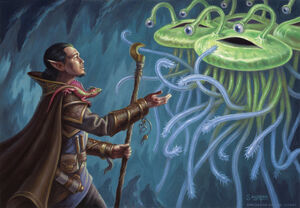Flumphs were mysterious and benevolent creatures that drifted through the Underdark.[1]
Description
A flumph's body was shaped like a flat saucer with a diameter slightly larger than a human from shoulder to shoulder, and about as thick as a human arm.[6]
Flumphs floated by means of an innate anti-gravity field,[7] and moved by using air jets as propulsion. In fact, they were named after the characteristic sound made by these jets.[1]
Flumphs also glowed faintly in different colors depending on their mood:[1]
- Pink: amusement
- Blue: sadness
- Green: curiosity
- Red: anger
Personality
Flumphs were wise and possessed advanced knowledge of philosophy and other subjects. They fed on psionic energy and were therefore more likely to be found near strong sources, such as aboleth, gith, and mind flayer settlements. However, due to their strong telepathic nature, flumphs were very sensitive to evil thoughts and felt the need to share them as quickly as possible with any good-aligned creatures they found, in order to wash these thoughts away.[1]
It was also common for flumphs exposed to evil thoughts to spontaneously glow red in anger. This reaction was considered a sign to adventurers that evil monsters lurked nearby.[6]
Combat
Normally, a flumph's reaction when facing an evil creature was to flee. However, flumphs' tendrils were acidic and could be used as defensive weapons if necessary.[1] They also had the ability to shoot a sticky, foul-smelling fluid whose odor lasted for several hours.[6]
They were capable of overhearing any telepathic conversation held within a range of 60 feet (18 meters), but were immune to attempts at reading their thoughts or their emotions against their will.[6]
Society
Flumph society was organized in harmonious cooperative groups called "cloisters", in which all flumphs contributed according to their own skills.[1] They were also known for sometimes recruiting isolated mindwitnesses into their communities. Once a mindwitness was taken in service of the flumphs, it would change its world view accordingly and was no longer an evil creature.[8]
Flumphs were largely ignored by mind flayers, who had no interest in them. For that reason, it was relatively common to find cloisters of flumphs near mind flayer settlements. On the other hand, githyanki abhorred flumphs violently, and attacked them on sight.[9]
History
The origin of the flumphs was ultimately a mystery. It was speculated that flumphs were genetically related to grells or belabras, due to some physiological similarities such as their hovering and the presence of tentacles. Given the probable genetic ties to the grells, most sages agreed that flumphs originated in a different world and traveled as clandestine passengers in grell spelljammer ships.[10]

A cloister of flumphs curiously examining a visitor to Undermountain.
During the late 1480s DR, flumphs were greatly disturbed by the demonic madness that permeated the Underdark. Some offered assistance to anyone who opposed the derro cultists under Gracklstugh, while a cloister of flumphs from the Wormwrithings maintained that kindness was the only appropriate response during those evil times.[11]
Around 1492 DR,[note 1] a cloister of flumphs inhabited the Seadeeps level of Undermountain, feeding off the psionic energy of the nearby illithid and githyanki settlements.[9]
Notable Flumphs
- Laal, an erudite female flumph who contacted a group of adventurers to seek justice for the murder of her mate, Xol;[12]
- Xol, an adventurous male flumph who was murdered by the Cult of the Crushing Wave in an expedition to Mulmaster's sewers.[12]
Appendix
Notes
- ↑ Canon material does not provide a year for the events described in Waterdeep: Dragon Heist, but Christopher Perkins answered a question via Twitter and stated the year was 1492 DR. Corroborating this, Dragon Heist page 20 refers to events of Death Masks (set in 1491 DR) as being "last year". Unless a canon source contradicts this assertion, this wiki will use 1492 DR for events related to this sourcebook and Waterdeep: Dungeon of the Mad Mage (which is referenced on pages 5 and 98 of Dragon Heist).
Appearances
References
- ↑ 1.00 1.01 1.02 1.03 1.04 1.05 1.06 1.07 1.08 1.09 1.10 Mike Mearls, Jeremy Crawford, Christopher Perkins (2014-09-30). Monster Manual 5th edition. Edited by Scott Fitzgerald Gray. (Wizards of the Coast), p. 135. ISBN 978-0786965614.
- ↑ Logan Bonner, Chris Sims (April 2009). Dungeon Delve: Fool's Grove (PDF). Wizards of the Coast. p. 8. Retrieved on 2016-12-07.
- ↑ 3.0 3.1 3.2 3.3 Tim Hitchcock (January 2005). “Box of Flumph”. In Erik Mona ed. Dungeon #118 (Paizo Publishing, LLC) (118)., pp. 30–31.
- ↑ 4.0 4.1 4.2 Jon Pickens ed. (1995). Monstrous Compendium Annual Volume Two. (TSR, Inc.), p. 58. ISBN 0-7869-0199-3.
- ↑ Don Turnbull (1981). Fiend Folio. (TSR Hobbies), p. 39. ISBN 0-9356-9621-0.
- ↑ 6.0 6.1 6.2 6.3 Jim Zub, Stacy King, Andrew Wheeler (July 2019). Monsters & Creatures. (Ten Speed Press), pp. 10–11. ISBN 978-1-9848-5640-1.
- ↑ Johnathan M. Richards (April 1998). “The Ecology of the Flumph”. In Dave Gross ed. Dragon #246 (TSR, Inc.), p. 78.
- ↑ Mike Mearls, et al. (November 2016). Volo's Guide to Monsters. Edited by Jeremy Crawford, et al. (Wizards of the Coast), p. 176. ISBN 978-0786966011.
- ↑ 9.0 9.1 Christopher Perkins (November 2018). Waterdeep: Dungeon of the Mad Mage. Edited by Jeremy Crawford. (Wizards of the Coast), pp. 222, 224. ISBN 978-0-7869-6626-4.
- ↑ Johnathan M. Richards (April 1998). “The Ecology of the Flumph”. In Dave Gross ed. Dragon #246 (TSR, Inc.), p. 81.
- ↑ 11.0 11.1 Christopher Perkins, Adam Lee, Richard Whitters (September 1, 2015). Out of the Abyss. Edited by Jeremy Crawford. (Wizards of the Coast), pp. 67, 167. ISBN 978-0-7869-6581-6.
- ↑ 12.0 12.1 12.2 Tim Eagon (2015-06-01). Foulness Beneath Mulmaster (DDEX2-08) (PDF). D&D Adventurers League: Elemental Evil (Wizards of the Coast), pp. 5, 10.
